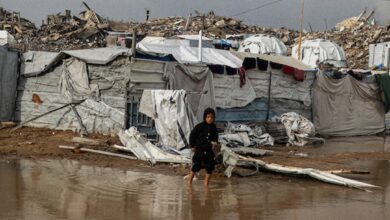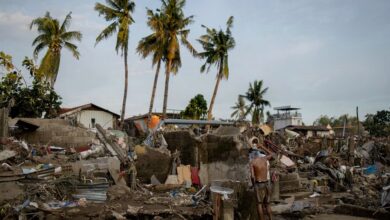
WAVELAND, Miss. (AP) — Hurricane Sally, a plodding storm with winds of 85 mph (137 kph), crept toward the northern Gulf Coast early Tuesday as forecasters warned of potentially deadly storm surges and flash floods with up to two feet (.61 meters) of rain and the possibility of tornadoes.
Hurricane warnings had stretched from Grand Isle, Louisiana to Navarre, Florida, but forecasters, while stressing “significant” uncertainty, kept nudging the predicted track eastward, easing fears in New Orleans, which was once in Sally’s crosshairs.
On the current track, the storm is forecast to reach land near the Alabama-Mississippi state line by late Tuesday or early Wednesday.
Stacy Stewart, a senior specialist with the National Hurricane Center, said Tuesday that people should continue to take the storm seriously since “devastating” rainfall is expected in large areas. People could drown in the flooding, he said.
“This is going to be historic flooding along with the historic rainfall,” Stewart said. “If people live near rivers, small streams and creeks, they need to evacuate and go somewhere else.”
The storm was moving at only two mph (four kph) before dawn on Tuesday, centered about 115 miles (185 kilometers) south-southeast of Biloxi, Mississippi, and 60 miles (97 kilometers) east-southeast of the mouth of the Mississippi River.
Forecasters expect Sally to turn northward Tuesday afternoon, moving near the coast of southeastern Louisiana later in the day, and then travel slowly north-northeastward through Wednesday, with top winds increasing to 110 mph (177 kph), nearly Category 3, before blowing ashore.
Florida Gov. Ron DeSantis declared an emergency in the Panhandle’s westernmost counties, which were being pummeled by rain from Sally’s outer bands early Tuesday. The threat of heavy rain and storm surge was exacerbated by the storm’s slow movement.
President Donald Trump issued emergency declarations for parts of Louisiana, Mississippi and Alabama on Monday, and tweeted that residents should listen to state and local leaders.
Alabama Gov. Kay Ivey sought the presidential declaration after the National Weather Service in Mobile, Alabama, warned of the increasing likelihood of “dangerous and potentially historic flooding,” with waters rising as much as nine feet (2.7 meters) above ground in parts of the Mobile metro area.
It all seemed a distant threat Monday afternoon in Waveland, Mississippi, as a shirtless, barefooted Trevor Claunch, of nearby Bay St. Louis, got in some last-minute beach time. But there were signs of trouble coming. Claunch marveled at how the Gulf waters had already crept over swaths of sandy shore and infiltrated bike paths and parking lots.
“Without any rain, and it’s already all the way up — I honestly want to stick around and see where it goes,” said Claunch.
But he wasn’t taking any chances.
“We’re going to go inland,” he said.
Sally achieved hurricane strength Monday and quickly intensified to a Category 2 storm with 100 mph (161 kph) winds. Its maximum sustained winds dwindled to a Category 1 by early Tuesday, but forecasters expect it to grow stronger again before landfall.
While the threat to Louisiana appeared to be easing, flood control authorities remained on guard, closing gates along networks of waterways that could be pushed over their banks by the possible surge from the Gulf.
The southwestern part of the state was pummeled by Hurricane Laura on Aug. 27 and an estimated 2,000 evacuees from that storm were sheltered in New Orleans, mostly in hotels.
Monday marked only the second time on record, forecasters said, that five tropical cyclones swirled simultaneously in the Atlantic basin. The last time that happened was in 1971. None of the others were expected to threaten the US this week, if at all, and one was downgraded to a low pressure trough Monday evening.
The extraordinarily busy hurricane season — like the catastrophic wildfire season on the West Coast — has focused attention on the role of climate change.
Scientists say global warming is making the strongest of hurricanes, those with wind speeds of 110 mph or more, even stronger. Also, warmer air holds more moisture, making storms rainier, and rising seas from global warming make storm surges higher and more damaging.
In addition, scientists have been seeing tropical storms and hurricanes slow down once they hit the United States by about 17 percent since 1900, and that gives them the opportunity to unload more rain over one place, as 2017’s Hurricane Harvey did in Houston.
People along the coast appeared to be taking the storm seriously even as it remained offshore. Coastal casinos shut down under orders from the Mississippi Gaming Commission. Motorists filled a convenience store parking lot in Ocean Springs, Mississippi, as they topped off gas tanks and stocked up on ice, beer and snacks.
“It’s second nature to us. It would have already been done but I had to work,” Zale Stratakos said as she helped her mother, Kimberly Stratakos, fill three plastic gasoline cans.
___
Martin reported from Marietta, Georgia. Associated Press reporters Rebecca Santana and Janet McConnaughey in New Orleans; Seth Borenstein in Kensington, Maryland; Emily Wagster Pettus and Leah Willingham, in Jackson, Mississippi; and Kim Chandler in Montgomery, Alabama, contributed to this report.
Image: Nikita Pero of Gulfport, Miss., walks with her son Vinny Pero, 2, on the beach along the Gulf of Mexico in Biloxi, Miss., Monday, Sept. 14, 2020. Hurricane Sally is expected to make landfall along the Gulf Coast sometime through the night and morning. (AP Photo/Gerald Herbert)




